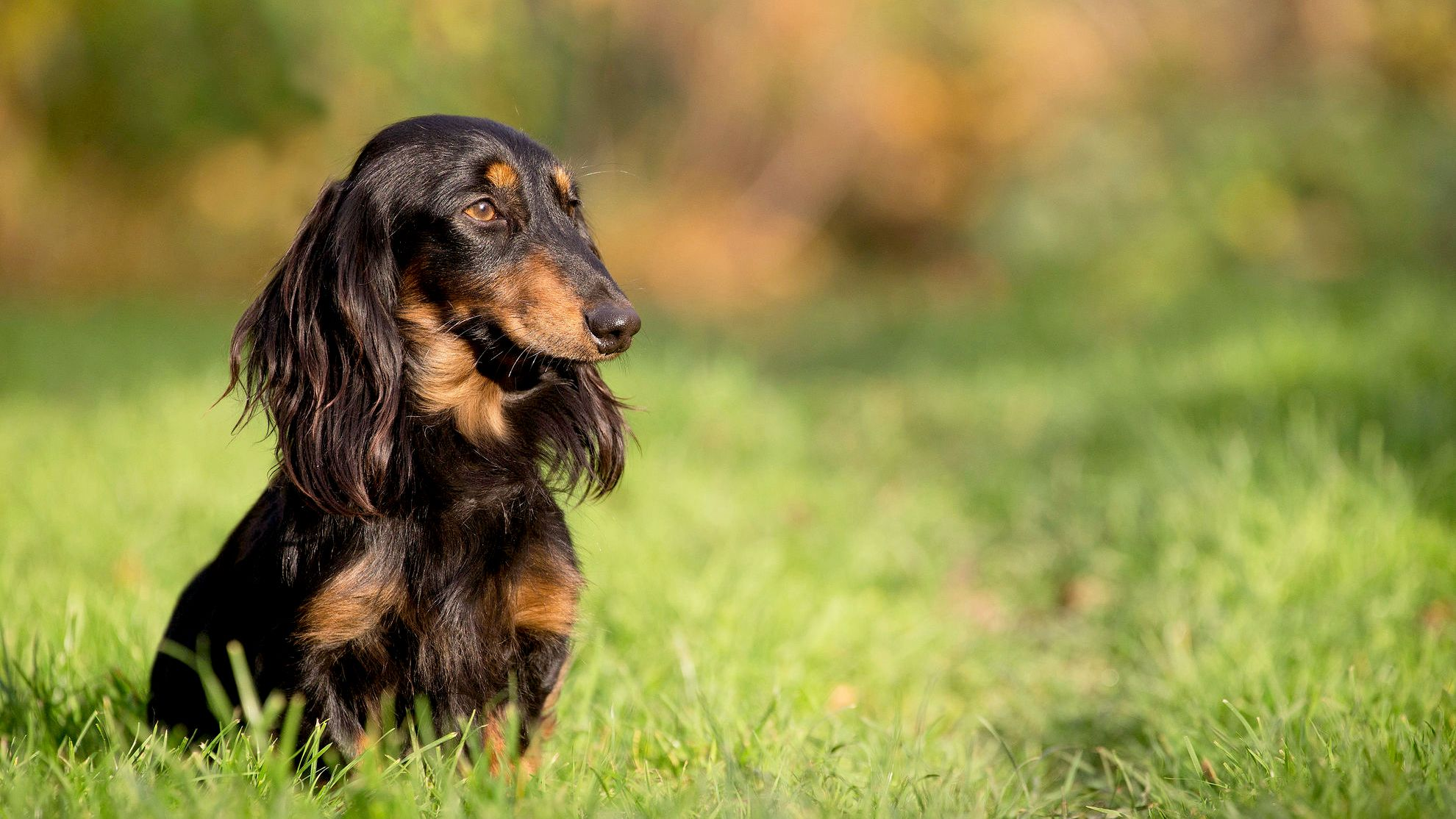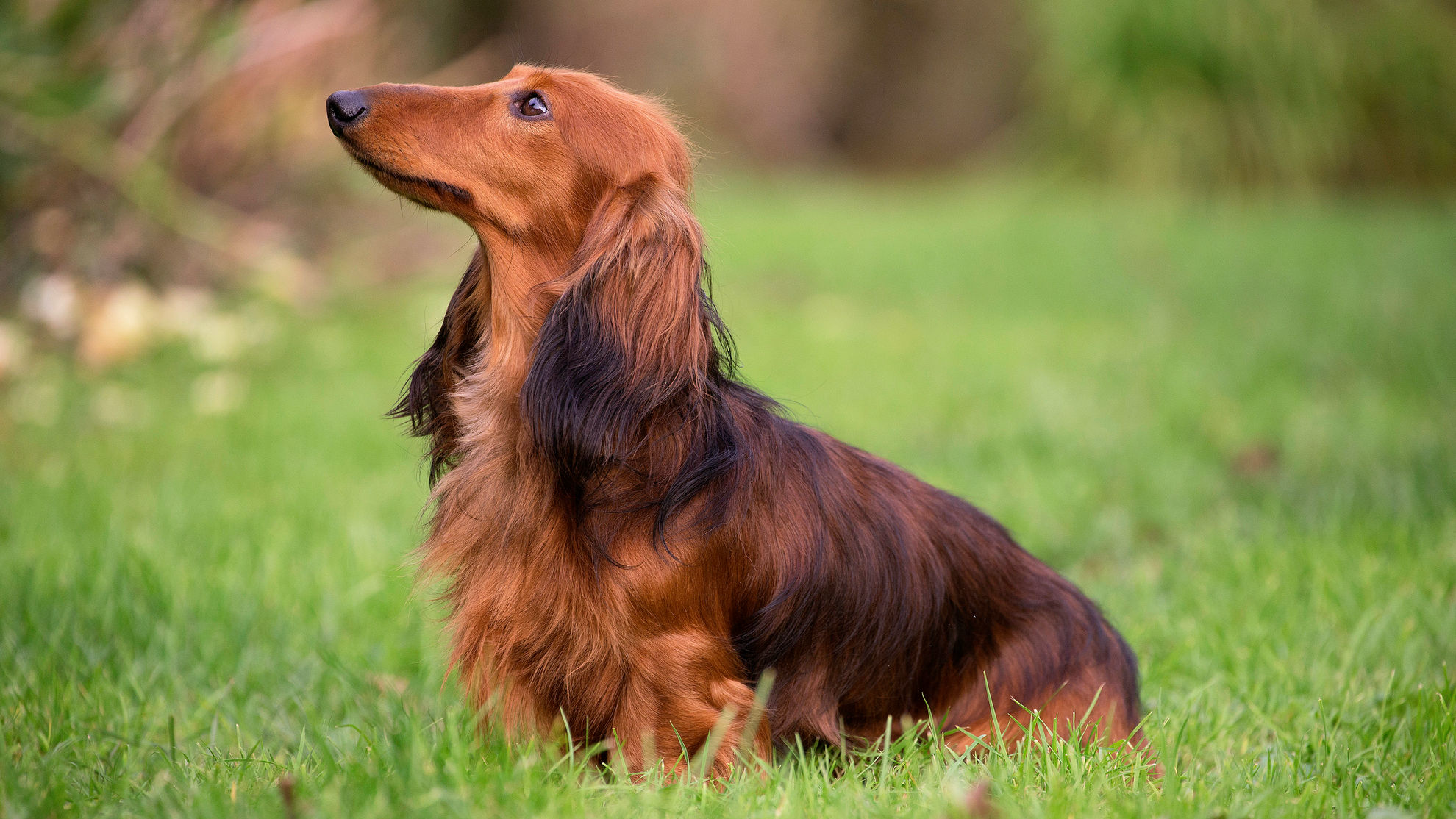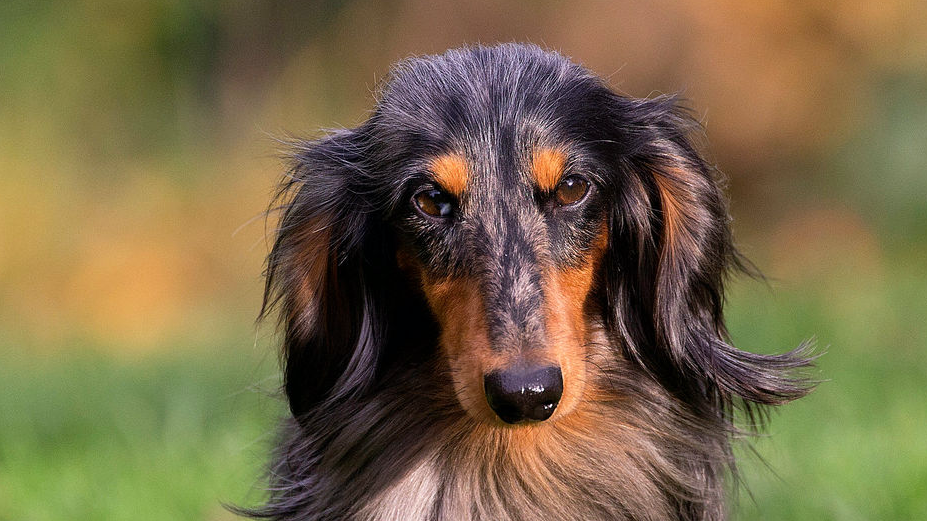Let's talk Standard Long-Haired Dachshunds
Official name: Standard Wire-Haired Dachshund
Other names: Doxie, Dashie, Badger Dog
Origins: Germany
Drooling tendencies
1 out of 5Grooming needs
4 out of 5Shedding Level
3 out of 5Barking tendencies
3 out of 5Energy level
3 out of 5Compatibility with other pets
2 out of 5Warm weather?
3 out of 5Cold weather?
1 out of 5Suited to apartment living
3 out of 5Can be left alone
3 out of 5Family pet
2 out of 5
| Male | Female |
|---|---|
| Height | Height |
| 37 - 47 cm | 35 - 45 cm |
| Weight | Weight |
| 9 - 12 kg | 9 - 12 kg |
| Life Stage | |
|---|---|
| Puppy | Adult |
| 2 to 10 months | 10 months to 8 years |
| Mature | Senior |
| 8 to 12 years | From 12 years |
Drooling tendencies
1 out of 5Grooming needs
4 out of 5Shedding Level
3 out of 5Barking tendencies
3 out of 5Energy level
3 out of 5Compatibility with other pets
2 out of 5Warm weather?
3 out of 5Cold weather?
1 out of 5Suited to apartment living
3 out of 5Can be left alone
3 out of 5Family pet
2 out of 5
| Male | Female |
|---|---|
| Height | Height |
| 37 - 47 cm | 35 - 45 cm |
| Weight | Weight |
| 9 - 12 kg | 9 - 12 kg |
| Life Stage | |
|---|---|
| Puppy | Adult |
| 2 to 10 months | 10 months to 8 years |
| Mature | Senior |
| 8 to 12 years | From 12 years |

Get to know the Standard Long-Haired Dachshund
All you need to know about the breed
The Standard Long-Haired Dachshund is just one of three Dachshund coat types, the others being the Wire-Haired and Smooth-Haired. There are these Dachshund sizes too: Miniature, Standard, and Kaninchen. Kaninchen is German for “rabbit,” with these dogs measuring at 11.8 inches and weighing no more than 7.7lbs. They were bred to burrow and hunt rabbits or other small animals.
The Standard Long-Haired Dachshund is one breed that’s easy to have around. Known for their warm heart, you’ll always find the affectionate Dachshund right by your side. And, with a lifespan of anywhere from 12 to 16 years, that means a lot of together-time.
With an unruffled demeanour and tons of energy, they’re up for all kinds of games. But, as energetic as they are, this is one breed that’s never going to be a marathon buddy. Small jaunts around the block each day are enough to keep both little legs and a long body fit.
Standard Long-Haired Dachshunds should be kept warm as their small bodies don’t hold up to the cold. Canine-appropriate winter gear can be a good idea. And Dachshunds can certainly pull it off.

Two facts about Standard Long-Haired Dachshunds
1. Dachshunds can be suspicious of strangers
The Standard Long-Haired Dachshund personality is one that’s standoffish, especially around newcomers. They prefer to strongly attach to one person. So, it’s important to train your dog early to ensure they are as social as possible and prevent any nipping at strangers.
2. Small size, big bark
Despite their diminutive size, Standard Long-Haired Dachshunds have a huge bark – a result of their Scent Hound history. After burrowing deep into the earth for prey, their bark would alert the hunters above that they might have found something.
History of the breed
The German Dachshund Club was formed in 1888, with the Dachshund becoming a member of the American Kennel Club studbook in 1885. But with anti-German sentiment rising during and after World War II, American fans of the friendly breed changed their name to Liberty Hounds, though the name never took. This even-tempered breed is now cherished the world over.
From head to tail
Physical characteristics of Standard Long-Haired Dachshunds
1.Ears
2.Head
3.Body
4.Fur
5.Tail

Things to look out for
From specific breed traits to a general health overview, here are some interesting facts about your Standard Long-Haired Dachshund
Don’t let your Dachshund jump too much
Actions like jumping from furniture or climbing stairs can cause injury to the Standard Long-Haired Dachshund. With very short legs supporting their torso, sudden athletic movements can hurt their long backs. Keep an eye on your dog and ensure you’re giving them regular exercise to keep their back and legs strong.
Likes to hunt and dig
Standard Long-Haired Dachshunds were bred for digging, and it can be hard to shake any in-bred traits. You may find your dog wants to dig through plants, the garden, or even laundry and personal belongings, just to satisfy their innate drive. They can, however, be trained to tone down this tendency. Doing so early is key.
Tailored nutrition for Standard Long-Haired Dachshunds

When choosing food for a Standard Long-Haired Dachshund, there are many factors to consider: their age, lifestyle, activity level, physiological condition, and health including potential sickness or sensitivities. Food provides energy to cover a dog’s vital functions, and a complete nutritional formula should contain an adjusted balance of nutrients to avoid any deficiency or excess in their diet, both of which could have adverse effects on the dog. Clean and fresh water should be available at all times to support your dog’s urinary health. In hot weather and especially when out exercising, bring water along for your dog’s frequent water breaks. The following recommendations are for healthy animals. If your dog has health problems, please consult your veterinarian who may prescribe an exclusive veterinary diet.
Immune System Support
As puppies grow, they will experience big changes and new experiences. During this period, the puppy's immune system develops gradually. Dachshund Puppy helps support your puppy's natural defences with an exclusive complex of antioxidants including Vitamin E.
Joint & Bone Support
Balanced energy intake and precise mineral content (calcium and phosphorus) contribute to the development of strong bones and healthy joints in Dachshund puppies. This exclusive diet also helps maintain ideal weight.
Digestive Health
Formulated with high quality protein (L.I.P.*) and prebiotics to support digestive health and a balanced intestinal flora, contributing to optimal stool quality. *Protein selected for its high digestibility.

The main nutritional goals for adult Standard Long-Haired Dachshunds are:
Joint & Bone Support
Standard Long-Haired Dachshunds have short limbs and vertebrae which are subjected to severe mechanical stresses. Dachshund Adult helps support the Standard Long-haired Dachshund’s healthy bones and joints with an appropriate calcium and phosphorus content. This exclusive formula also helps maintain ideal weight.
Muscle Tone
This formula helps maintain the Dachshund's muscle tone with an appropriate protein content. Contains L-carnitine.
Stool & Odor Reduction
This formula helps reduce fecal smell and volume, and it helps support good digestion with highly digestible proteins (L.I.P*), an appropriate fibre content and high-quality carbohydrate sources. *Protein selected for its very high digestibility.
Exclusive Kibble
The kibble has been developed to be perfectly adapted to the small jaw of the Dachshund. It makes it easy for the Dachshund to pick up and chew.

After 8 years old, Standard Long-Haired Dachshunds start facing the first signs of aging. A formula enriched with antioxidants will help maintain their vitality, and an adapted phosphorus content will support their renal system. Aging is also accompanied by the modification of digestive capacities and particular nutritional requirements, so food for older Dachshunds should have the following characteristics:
Healthy Aging Complex
Dachshund Adult 8+ is formulated with a precise phosphorous content and a complex of antioxidants to help maintain optimal health in the maturing Dachshund.
Bone & Joint Support
The Standard Long-Haired Dachshund has short vertebrae and limbs, and therefore they tend to have more mechanical joint stress compared to other breeds. Dachshund Adult 8+ supports the Dachshund's bones and joints with EPA & DHA and as precise levels of calcium and phosphorus.
Ideal Weight
Excess weight gain can impact the health of the Standard Long-Haired Dachshund so an appropriately balanced diet is essential in maintaining optimal health. Dachshund Adult 8+ has adjusted nutrients and calories compared to Dachshund Adult to help maintain the ideal weight as the maturing Dachshund.
Highly Palatable & Rehydratable Kibble
The kibble size, shape and texture are designed for the mature Standard Long-Haired Dachshund and his small jaw. Kibble may be softened with warm water to allow for easier eating.

Caring for your Standard Long-Haired Dachshund
Grooming, training, and exercise tips
A natural-born athlete, the Standard Long-Haired Dachshund needs plenty of exercise. Twice-daily walks are recommended but never long jogs – Standard Long-Haired Dachshund and running do not mix. A fenced-in yard is enough to give this breed room to run to their heart’s content.
The Standard Long-Haired Dachshund is known for its short and sleek coat, which is typically very shiny if cared for properly. Twice-weekly brushing of your Dachshund should keep it well groomed. Bathe only when needed to keep the coat in good shape. Nail trims are recommended once or twice per month. Teeth, however, should be brushed at least two to three times a week – daily if you can get away with it.
Standard Long-Haired Dachshunds are very easy to train. Their sporting background has trained the breed as a digger, terrier, and scrubber, so training should be early and firm. Since they’re strong-willed, patience is your friend. Standard Long-Haired Dachshund traits include courage and boldness, so they’ll need to know who is in charge. Independence is a plus but make sure they don’t wander off as a result. Dachshunds normally get along with other dogs and cats in the house but at times can be assertive.
A natural-born athlete, the Standard Long-Haired Dachshund needs plenty of exercise. Twice-daily walks are recommended but never long jogs – Standard Long-Haired Dachshund and running do not mix. A fenced-in yard is enough to give this breed room to run to their heart’s content.
The Standard Long-Haired Dachshund is known for its short and sleek coat, which is typically very shiny if cared for properly. Twice-weekly brushing of your Dachshund should keep it well groomed. Bathe only when needed to keep the coat in good shape. Nail trims are recommended once or twice per month. Teeth, however, should be brushed at least two to three times a week – daily if you can get away with it.
Standard Long-Haired Dachshunds are very easy to train. Their sporting background has trained the breed as a digger, terrier, and scrubber, so training should be early and firm. Since they’re strong-willed, patience is your friend. Standard Long-Haired Dachshund traits include courage and boldness, so they’ll need to know who is in charge. Independence is a plus but make sure they don’t wander off as a result. Dachshunds normally get along with other dogs and cats in the house but at times can be assertive.
7/7
All about Standard Long-Haired Dachshunds
The Standard Long-Haired Dachshund is one of three varieties of the distinctive long-bodied and charming dog – one of the most popular breeds there is. Dachshunds can also be Smooth-Haired and Wire-Haired, with all other characteristics remaining the same, save for their coat and their many colourings. The breed is known to be lively and playful but also needs solid companionship, attaching easily to one person as well as to their family.
Their long and shiny coat is a great choice but the breed is in an almost permanent state of molt, shedding its old coat to make way for the new. It won’t come out in clumps but in miniscule amounts each day. Brushing your Standard Long-Haired Dachshund must be consistent – once a day or every other day should work.
Other breeds that might interest you
Read more on this topic
Sources
- Veterinary Centers of America https://vcahospitals.com/
- Royal Canin Dog Encyclopaedia. Ed 2010 and 2020
- Banfield Pet Hospital https://www.banfield.com/
- Royal Canin BHN Product Book
- American Kennel Club https://www.akc.org/
Like & share this page